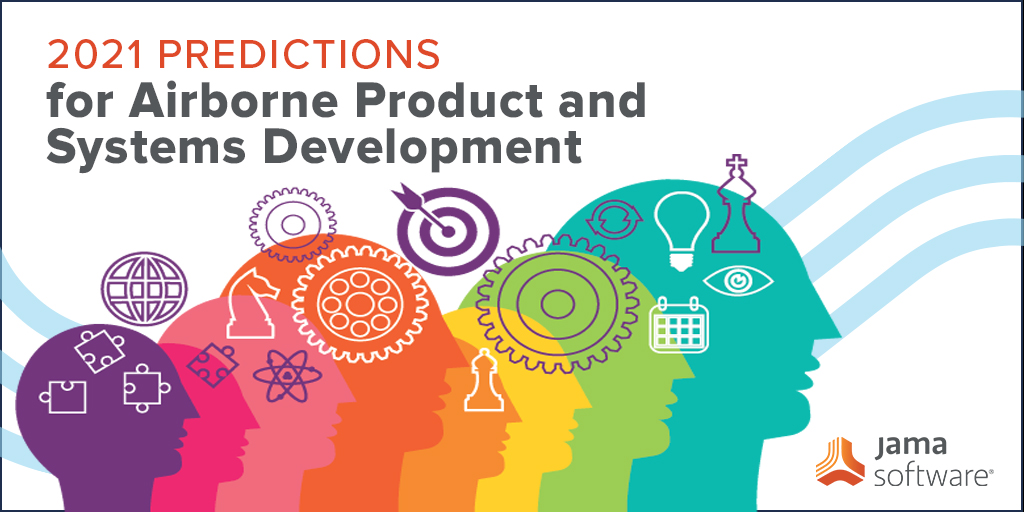Airborne Product and Systems Development
2020 has been a year that’s been described as “unprecedented” and “unparalleled” – as well as other descriptors probably best left out of our blog. As we close out this year, it’s hard to say what awaits us in the new one. One thing that we can be sure of is that innovation in medicine, science, and technology shows no sign of slowing down.
As we enter a new year of technological advancements, Jama Software asked select thought leaders – both internal and external – across various industries for the trends and events they foresee unfolding over the next year and beyond.
In Part II of our four-part series, we ask Cary Bryczek, Director of Solutions Architecture at Jama Software, to weigh in on trends she sees in the airborne systems industry (known to some as aerospace and defense) for 2021.
Note: Now that our 2021 Predictions Series is complete, you can also go back and read, Part I, Part III, and Part IV
What product, systems, and software development trends are you expecting to take shape in 2021?
Cary Bryczek:
Urban air mobility and air taxis will not increase as companies are halting their development due to sagging market for personal transportation. Instead we are seeing an uptick in electric propulsion engines since the market continues to expand for unmanned systems in cargo shipping, agricultural application, and all-electric aircraft interest. Rolls Royce, Eviation, and even NASA are leading the way.
In terms of product and systems development, what do you think will remain the same over the next decade? What will change?
Cary Bryczek:
Products will continue to include more and more software in the next decade but software and hardware development tools will still remain loosely federated from each other.
How do you foresee regulations shifting in the aerospace and defense industry over the next decade?
Cary Bryczek:
Contracts on the defense and space side will be morphing to allow for more Agile/iterative styles of both contract response as well as design and development of systems. Contractors will be considered more closely to be a partner than the stereotype of a contractor. Contractors who are prepared with tooling that supports a more integrated digital ecosystem and collaborative environment will be better equipped for success.
RELATED: Jama Connect in the Digital Engineering Ecosystem
Any major disruptions to the aerospace and defense industry you’re anticipating in 2021?
Cary Bryczek:
COVID-19 will continue to wreak havoc across this segment. Companies that are developing systems that are attractive to the commercial consumer will be finding new avenues to support their business.
What sorts of process adjustments do you think development teams will need to make to be successful in 2021?
Cary Bryczek:
Teams will need to commit to broader cyber security processes and development controls to prevent exposure of both personal data and intellectual property. As more workers are working from home, the risk exposure is significantly greater. There will be more permissions controls around requirements data, verification results, and design data. The processes used to produce the design data whether that is generated by an DevSecOps process or hardware waterfall design will have added layers of process review.
What do you think will be some of the differentiators between a company surviving to see 2030, and those that do not?
Cary Bryczek:
Companies will need to be able to retain engineering talent and be able to future proof the products and systems they design; those that do will be more likely to succeed. These companies will be offering more professional education and access to the latest tools and technologies as an incentive to retain the talent. Companies that bring in talent from adjacent market segments will be the big winners.
Where do you see Jama Software fitting in as the product development landscape evolves, and what can our customers expect as 2021 approaches?
Cary Bryczek:
Work is now almost being performed by a 100% remote workforce in the commercial world. The defense and space world will feel the pressure from workers to utilize tools in the workplace that are now a commodity at home. As companies continue their journey to create digital ecosystems, Jama Connect will become connected with more tools in that ecosystem.
Stay tuned in the coming weeks for additional 2021 predictions! In the meantime, to see more information specific to the airborne systems industry, we’ve compiled a handy list of valuable resources for you!
- [Webinar Recap] The New ARP4754B: Tips for Engineers & Quality Teams - December 30, 2024
- [Webinar Recap] Elevating MBSE with SysML: Jama Connect® and CATIA Magic in Action - September 17, 2024
- SysML is Not Enough: Why You Still Need a Requirements Management Tool - July 18, 2024
